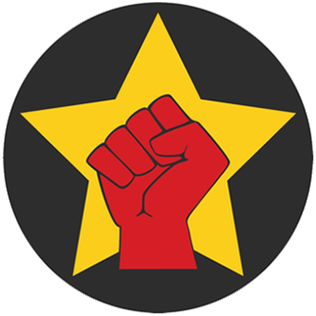
Slacktivism is the practice of supporting a political or social cause by means such as social media or online petitions, characterized as involving very little effort or commitment. Additional forms of slacktivism include engaging in online activities such as "liking," "sharing," or "tweeting" about a cause on social media, signing an Internet petition, copying and pasting a status or message in support of the cause, sharing specific hashtags associated with the cause, or altering one's profile photo or avatar on social network services to indicate solidarity.

Media activism is a broad category of activism that utilizes media and communication technologies for social and political movements. Methods of media activism include publishing news on websites, creating video and audio investigations, spreading information about protests, or organizing campaigns relating to media and communications policies.
Internet activism and, specifically, social networking has been instrumental in organizing many of the 2009 Iranian election protests. Online sites have been uploading amateur pictures and video, and Twitter, Facebook, and blogs have been places for protesters to gather and exchange information. Although some scholars in the West stress that Twitter has been used to organize protests, Iranian scholars argue that Twitter was hardly used by Iranian citizens in the midst of the 2009 protests.
Since the launch of X on July 15, 2006, there have been many notable uses for the service in a variety of environments, including political, economic, social and cultural uses. As users post/tweet their messages on X, they encourage other people to respond and engage in online discussions as well as offline activities. User engagement on X is usually measured with likes, replies and reposts/retweets and is a form of social power.

The Tunisian Revolution, also called the Jasmine Revolution and Tunisian Revolution of Dignity, was an intensive 28-day campaign of civil resistance. It included a series of street demonstrations which took place in Tunisia, and led to the ousting of longtime dictator Zine El Abidine Ben Ali in January 2011. It eventually led to a thorough democratization of the country and to free and democratic elections, which had led to people believing it was the only successful movement in the Arab Spring.

The 2011 Egyptian revolution, also known as the 25 January Revolution, began on 25 January 2011 and spread across Egypt. The date was set by various youth groups to coincide with the annual Egyptian "Police holiday" as a statement against increasing police brutality during the last few years of Hosni Mubarak's presidency. It consisted of demonstrations, marches, occupations of plazas, non-violent civil resistance, acts of civil disobedience and strikes. Millions of protesters from a range of socio-economic and religious backgrounds demanded the overthrow of Egyptian President Hosni Mubarak. Violent clashes between security forces and protesters resulted in at least 846 people killed and over 6,000 injured. Protesters retaliated by burning over 90 police stations across the country.
Censorship of Twitter, refers to Internet censorship by governments that block access to Twitter. Twitter censorship also includes governmental notice and take down requests to Twitter, which it enforces in accordance with its Terms of Service when a government or authority submits a valid removal request to Twitter indicating that specific content is illegal in their jurisdiction.

The Arab Spring or the First Arab Spring was a series of anti-government protests, uprisings and armed rebellions that spread across much of the Arab world in the early 2010s. It began in Tunisia in response to corruption and economic stagnation. From Tunisia, the protests then spread to five other countries: Libya, Egypt, Yemen, Syria and Bahrain. Rulers were deposed or major uprisings and social violence occurred including riots, civil wars, or insurgencies. Sustained street demonstrations took place in Morocco, Iraq, Algeria, Lebanon, Jordan, Kuwait, Oman and Sudan. Minor protests took place in Djibouti, Mauritania, Palestine, Saudi Arabia and the Moroccan-occupied Western Sahara. A major slogan of the demonstrators in the Arab world is ash-shaʻb yurīd isqāṭ an-niẓām!.

Wael Ghonim is an Internet activist and computer engineer with an interest in social entrepreneurship.

The Revolutionary Socialists (RS) are a Trotskyist organisation in Egypt originating in the tradition of 'Socialism from Below'. Leading RS members include sociologist Sameh Naguib. The organisation produces a newspaper called The Socialist.
USAbilAraby is the name used by the US Department of State's Arabic Media Hub for its Twitter account and YouTube channel. The name, "USAbilAraby," means "USA in Arabic." As this suggests, the Twitter account tweets messages from the US government, primarily in Arabic and typed in Arabic script. Similarly, the YouTube channel broadcasts official messages in Arabic. USAbilAraby's first tweet appeared on February 9, 2011; its first video was posted on May 4, 2011.
The Egyptian Communist Party (ECP) is a revolutionary Marxist–Leninist communist party in Egypt.
Networked feminism is a phenomenon that can be described as the online mobilization and coordination of feminists in response to sexist, misogynistic, racist, and other discriminatory acts against minority groups. This phenomenon covers all possible definitions of what feminist movements may entail, as there have been multiple waves of feminist movements and there is no central authority to control what the term "feminism" claims to be. While one may hold a different opinion from another on the definition of "feminism", all those who believe in these movements and ideologies share the same goal of dismantling the current patriarchal social structure, where men hold primary power and higher social privileges above all others. Networked feminism is not spearheaded by one singular women's group. Rather, it is the manifestation of feminists' ability to leverage the internet to make traditionally unrepresented voices and viewpoints heard. Networked feminism occurs when social network sites such as Facebook, Twitter and Tumblr are used as a catalyst in the promotion of feminist equality and in response to sexism. Users of these social media websites promote the advancement of feminism using tools such as viral Facebook groups and hashtags. These tools are used to push gender equality and call attention to those promoting anything otherwise. Online feminist work is a new engine of contemporary feminism. With the possibility of connecting and communicating all around the world through the Internet, no other form of activism in history has brought together and empowered so many people to take action on a singular issue.

Women played a variety of roles in the Arab Spring, but its impact on women and their rights is unclear. The Arab Spring was a series of demonstrations, protests, and civil wars against authoritarian regimes that started in Tunisia and spread to much of the Arab world. The leaders of Tunisia, Egypt, Libya, and Yemen were overthrown; Bahrain has experienced sustained civil disorder, and the protests in Syria have become a civil war. Other Arab countries experienced protests as well.
Hashtag activism refers to the use of Twitter's hashtags for Internet activism. The hashtag has become one of the many ways that social media contributes to civic engagement and social movements. The use of the hashtag on social media provides users with an opportunity to share information and opinions about social issues in a way that others (followers) can interact and engage as part of a larger conversation with the potential to create change. The hashtag itself consists of a word or phrase that is connected to a social or political issue, and fosters a place where discourse can occur. Social media provides an important platform for historically marginalized populations. Through the use of hashtags these groups are able to communicate, mobilize, and advocate for issues less visible to the mainstream.
Online social movements are organized efforts to push for a particular goal through the use of new communications and information technologies, such as the Internet. In many cases, these movements seek to counter the mainstream public, claiming there is a wrong that should be righted. Online social movements have focused on a broad range on social and political issues in countries all around the world.

Laila Shereen Sakr, known by her moniker, VJ Um Amel, is an Egyptian–American digital media theorist and artist. She is the founder of the digital lab, R-Shief, Inc., an Annenberg Fellow, and Assistant Professor of Media Theory & Practice at University of California, Santa Barbara, where she founded the Wireframe digital media studio.

The role of social media in the Arab Spring, a revolutionary wave of demonstrations and protests in the Middle East and North Africa between 2010 and 2012, remains a highly debated subject. Uprisings occurred in states regardless of their levels of Internet usage, with some states with high levels of Internet usage experiencing uprisings as well as states with low levels of Internet usage.
Vahid Online is the pseudonym of an Iranian blogger, netizen, Internet activist and Internet celebrity who is one of the most followed Iranians on almost any social network. He is a news geek and is considered by many of his followers as the source for daily news and information.
Since the Egyptian Revolution in 2011 and the Tunisian Revolution, social media, especially Facebook, Twitter, and YouTube, has started to gain traction as a political tool in Africa. Different political actors have used social media to achieve a wide variety of political motives. States actors can encourage political discourse, campaign via social media, or implement censorship and surveillance. Non-state actors, such as civil society organizations and opposition forces, can use social media as a way to address political concerns and use this space to organize wide-spread revolutions, such as the 2014 Burkinabé uprising. Meanwhile, extremist organizations can use social media to further their propaganda and recruitment. However, social media is criticized for its inaccessibility and spread of misinformation, causing some skepticism about effectiveness.









